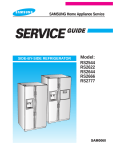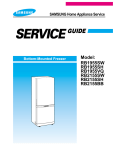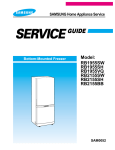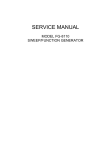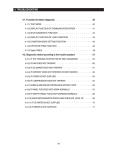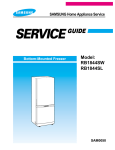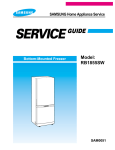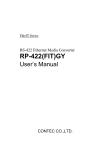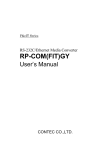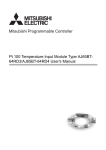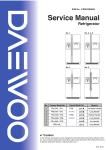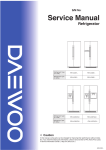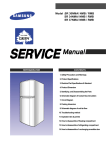Download Axor 41434XX1 Plumbing Product User Manual
Transcript
SAMSUNG Home Appliance Service SIDE-BY-SIDE REFRIGERATOR Model: RS2*3* RS2*2* RS2*1* SAM0096 WARNING IMPORTANT SAFETY NOTICE The service guide is for service men with adequate backgrounds of electrical, electronic, and mechanical experience. Any attempt to repair a major appliance may result in personal injury and property damage. The manufacturer or dealer cannot be responsible for the interpretation of this information. SAMSUNG ELECTRONICS AMERICA, INC. Technical Service Guide Copyright ⓒ2004 All rights reserved. This service guide may not be reproduced in whole or in part in any form without written permission from the SAMSUNG ELECTRONICS Company. 2 Contents 1. Safety instruction on services ······························ 4 2. Warranty information ···································9 3. Mechanical Disassembly ································14 4. Circuit Diagram ······································15 5. Operation Principles By Parts Of Circuit ························16 6. Illustrated Parts Catalog ·································26 ● Appendix Ⅰ(Reference for circuit diagnostics) 3 ····················31 1. Safety Instructions on Service ●Unplug the refrigerator before making any repair or any replacement. Avoid the electric shock. ●Use the rated components on the replacement. Check the correct model number, rated voltage, rated current, operating temperature and so on. ●On repair, be sure that the wires such as harness are bundled tightly and are not exposed by water. Bundle wires tightly in order not to be detached by the external force. ●On repair, remove completely dust, particles or other things on housing parts, harness parts, and connectors. Cleaning may prevent fire by tracking or short. ●Check if there is any trace indicating the infitration of water on electrical parts. If there is kind of trace, change the related components or do the necessary action such as taping using the insulating tape. ●After repair, check the assembled state of parts. It must be in the same assembled state when compared with the state before disassembly. ●Check the surrounding conditions of the installed refrigerator. When the refrigerator is located at humid or wet place, or the installed state is unstable, change the location. ●If needed, do the ground. Especially, if there is a possibility of the electric leakage, this appliance must be properly grounded. ●Do not allow consumers to use one outlet for several plugs. ●Check whether the power cord is placed under other appliance and so, damaged, worm-out squeezed. Repair immediately the defective power plug or outlet. Make sure that the power cord is not placed under other appliance or squeezed. ●Do not allow consumers to keep bottles or the likes in the Freezer or to keep foods in unstable position. ●Do not allow consumers to repair the appliance by themselves. ●Do not allow consumers to keep other chemicals except food. Medicines and other materials for research ; This appliance will not maintain the precisely constant temperature for them. Volatile material(Alcohol, Benzene, Ether, LP gas etc.) : possibility of explosion 4 2. Warranty information SAMSUNG REFRIGERATOR LIMITED WARRANTY TO ORIGINAL PURCHASER This SAMSUNG brand product, as supplied and distributed by Samsung Electronics America, Inc. (SAMSUNG) and delivered new, in the original carton to the original consumer purchaser, is warranted by SAMSUNG against manufacturing defects in materials and workmanship for a limited warranty period of: One (1) Year Parts and Labor on Refrigerator Five (5) Years Parts and Labor on Sealed Refrigeration System Only* (*Compressor, evaporator, condenser, drier, connecting tubing) This limited warranty begins on the original date of purchase, and is valid only on products purchased and used in the United States. To receive warranty service, the purchaser must contact SAMSUNG for problem determination and service procedures. Warranty service can only be performed by a SAMSUNG authorized service center. The original dated bill of sale must be presented upon request as proof of purchase to SAMSUNG or SAMSUNG's authorized service center. SAMSUNG will repair or replace any part found to be defective, at our option and at no charge as stipulated herein, with new or reconditioned parts during the limited warranty period specified above. All replaced parts and products become the property of SAMSUNG and must be returned to SAMSUNG. Replacement parts and products assume the remaining original warranty, or ninety (90) days, whichever is longer. In-home service will be provided during the warranty labor period subject to availability within the contiguous United States. Inhome service is not available in all areas. To receive in-home service, the product must be unobstructed and accessible from floor level to service personnel. If during in-home service repair cannot be completed, it may be necessary to remove, repair and return the product. If in-home service is unavailable, SAMSUNG may elect, at our option, to provide for transportation of our choice to and from a SAMSUNG authorized service center. Otherwise, transportation to and from the SAMSUNG authorized service center is the responsibility of the purchaser. This limited warranty covers manufacturing defects in materials and workmanship encountered in normal, noncommercial use of this product, and shall not apply to the following, including, but not limited to: damage which occurs in shipment; delivery and installation; applications and uses for which this product was not intended; altered product or serial numbers; cosmetic damage or exterior finish; accidents, abuse, neglect, fire, water, lightning or other acts of nature; use of products, equipment, systems, utilities, services, parts, supplies, accessories, applications, installations, repairs, external plumbing and leaks, external wiring, circuit breakers, fuses or connectors not supplied and authorized by SAMSUNG, or which damage this product or result in service problems; incorrect electrical line voltage, fluctuations and surges; customer adjustments and failure to follow operating instructions, cleaning, maintenance and environmental instructions that are covered and prescribed in the instruction book; loss of food due to spoilage; consumable items including filters and light bulbs. THERE ARE NO EXPRESS WARRANTIES OTHER THAN THOSE LISTED AND DESCRIBED ABOVE, AND NO WARRANTIES WHETHER EXPRESS OR IMPLIED, INCLUDING, BUT NOT LIMITED TO, ANY IMPLIED WARRANTIES OF MERCHANTABILITY OR FITNESS FOR A PARTICULAR PURPOSE, SHALL APPLY AFTER THE EXPRESS WARRANTY PERIODS STATED ABOVE, AND NO OTHER EXPRESS WARRANTY OR GUARANTY GIVEN BY ANY PERSON, FIRM OR CORPORATION WITH RESPECT TO THIS PRODUCT SHALL BE BINDING ON SAMSUNG. SAMSUNG SHALL NOT BE LIABLE FOR LOSS OF REVENUE OR PROFITS, FAILURE TO REALIZE SAVINGS OR OTHER BENEFITS, OR ANY OTHER SPECIAL, INCIDENTAL OR CONSEQUENTIAL DAMAGES CAUSED BY THE USE, MISUSE OR INABILITY TO USE THIS PRODUCT, REGARDLESS OF THE LEGAL THEORY ON WHICH THE CLAIM IS BASED, AND EVEN IF SAMSUNG HAS BEEN ADVISED OF THE POSSIBILITY OF SUCH DAMAGES. NOR SHALL RECOVERY OF ANY KIND AGAINST SAMSUNG BE GREATER IN AMOUNT THAN THE PURCHASE PRICE OF THE PRODUCT SOLD BY SAMSUNG AND CAUSING THE ALLEGED DAMAGE. WITHOUT LIMITING THE FOREGOING, PURCHASER ASSUMES ALL RISK AND LIABILITY FOR LOSS, DAMAGE OR INJURY TO PURCHASER AND PURCHASER’S PROPERTY AND TO OTHERS AND THEIR PROPERTY ARISING OUT OF THE USE, MISUSE OR INABILITY TO USE THIS PRODUCT SOLD BY SAMSUNG NOT CAUSED DIRECTLY BY THE NEGLIGENCE OF SAMSUNG. THIS LIMITED WARRANTY SHALL NOT EXTEND TO ANYONE OTHER THAN THE ORIGINAL PURCHASER OF THIS PRODUCT, IS NONTRANSFERABLE AND STATES YOUR EXCLUSIVE REMEDY. Some states do not allow limitations on how long an implied warranty lasts, or the exclusion or limitation of incidental or consequential damages, so the above limitations or exclusions may not apply to you. This warranty gives you specific legal rights, and you may also have other rights, which vary from state to state. To obtain warranty service, please contact SAMSUNG at: 061002 5 3. Mechanical Disassembly 3-1) Refrigerator Disassembly Control Panel ········································ 7 Door Handle ········································· 7 Door Gasket ········································· 7 Refrigerator Door Light Switch ······························· 7 Refrigerator Light ······································ 8 Tempered Glass Shelf ··································· 8 Plastic Drawers in Refrigerator ······························ 8 Gallon Door Bin ······································· 8 Water Filter ········································· 8 Damper in the Refrigerator ································ 9 Twin cool in the Refrigerator ······························· 9 Refrigerator Thermistor ·································· 9 3-2) Freezer Disassembly Door Bin in Freezer ···································· 10 Freezer Door Light Switch ································· 10 Plastic(Wire) Drawer in Freezer ······························ 10 Freezer Shelf ········································ 10 Ice Dispenser & Ice Maker ································ 10 Auger Motor Case ····································· 11 Freezer Light ········································ 12 Evaporator Cover in Freezer ································ 12 Evaporator Fan Motor ··································· 12 Evaporator in Freezer ··································· 13 Freezer Thermistor ····································· 13 Ambient Thermistor ····································· 13 Ice-Maker Thermistor ···································· 13 3-3) Machine Compartment Disassembly Machine Compartment & Electrix Box ··························14 Water Solenoids ······································14 Condenser Fan ·······································14 Sub-condenser ·······································14 6 3. Mechanical Disassembly 3-1) Refrigerator Disassembly Control Panel Door Gasket 1. Insert a flat-blade screwdriver on the slot as shown, and unlock the tabs. 2. Disconnect the wire connector. The door gasket is a molded gasket set into a channel located in the door liner. 1. Open the door. 2. Grasp the gasket and pull in an outward motion until the molded gasket separates from the door liner. Door Handle The door handles allow access into the refrigerator and freezer. They are front mounted with Phillips head screws. 1. With a small flat-blade screwdriver, press the small button and pull handle cover out. 2. Remove the Phillips screws (5). 3. Lift the handle with an in and upward motion until it disengages the locking tabs. Pull the handle outward to remove it. Refrigerator Door Light Switch The refrigerator has a door light switch located in the upper right corner for the refrigerator. 1. Use a small flat-blade screwdriver to unlock the locking tab and pull the switch out until the wire connector is visible. Button 7 Mechanical Disassembly Refrigerator Light The refrigerator light is located in the upper portion of refrigerator. 1. Pull the tip on the cover. Gallon Door Bin The door bins allow storage of perishable items. 1. Push the bin up and slide it out. Tempered Glass Shelf These shelves allow the storage of larger items and pull out for easy access. 1. Pull the shelf out as far as it goes. 2. Lift it up and remove it. Water Filter The water filter is located in the bottom left-hand corner of the refrigerator. The water filter filters water for the ice maker and the water dispenser. 1. Turn the water filter 1/2 turn counterclockwise and pull it down. 2. To install the filter, align the indication mark (unlock position) and push it up while turning 1/2 turn clockwise until the lock position is aligned. Do not over tighten. Plastic Drawers in Refrigerator Drawers are designed for storage of fruits, vegetables, and deli items. The drawers are located in the lower portion of the refrigerator. 1. Pull out the drawer as far as it goes. 2. Tilt the drawer up and pull it out until it is removed. 8 Mechanical Disassembly Damper in the Refrigerator 1. Pull out the screw cap and remove the screw. 2. Remove the lamp cover by unlocking the tabs and pulling the cover down. 3. Remove the screw at the cover damper. 4. Take off sensor and lamp wire connector located on the upper liner. 6. Remove the damper from the refrigerator. Refrigerator Thermistor The refrigerator thermistor is located inside of the upper light cover of the refrigerator. THERMISTOR Twin cool in the Refrigerator 1. Pull out the Twin cool by unlocking the hooks. 9 Mechanical Disassembly 3-2) Freezer Disassembly Door Bin in Freezer The door bins allow storage of perishable items. 1. Push the bin up and slide it out. Freezer Shelf The shelves slide out for easy access for frozen items. 1. Slide the shelf out until it reaches its stop. 2. Tilt down and slide it out of the compartment. Freezer Door Light Switch This switch is located in the left-hand portion of the freezer and sends a signal to the processor. 1. With a small flat-blade screwdriver, unlock the locking tabs and pull the switch out until the wire connector is visible. 2. Disconnect the wire connector and remove the switch. Plastic (Wire) Drawer in Freezer Drawers are designed for storage of meat and dry foods. The drawers are located in the lower portion of the freezer. 1. Pull out the drawer as far as it goes. 2. Tilt the drawer up and pull it out until it is removed. 10 Mechanical Disassembly top of the liner, and slide the ice maker in. 5. Tighten the screws (2) of the ice maker support. Ice Dispenser & Ice Maker The ice dispenser is located in the upper portion of the freezer. This assembly stores ice made by the icemaker and dispenses ice. 1. Lift the ice bucket up ① and slide out the ice dispenser assembly ②. FRONT LOCKING TAB TAB HOLES FRONT OF ICE TRAY GEARED MOTOR SHAFT Auger Motor Case This shelf is designed to support the ice maker & ice dispensed and Xtra SpaceTM. 1. Remove the Xtra SpaceTM cover to push it down and pull front. 2. Slide the partition out. 3. Remove the screws (2) on the bottom front of the case. 4. Slide out the case while disconnecting the wire connect. The ice maker is located inside of the ice dispenser assembly. 1. Remove ice maker support screws (2), and slide out. 2. Disconnect the ice maker wire connector. 3. Unlock the locking tabs to separate the ice maker kit. SUPPORT OF ICE-MAKER LOCKING TAB PARTITION WIRE CONNECTOR ICE-MAKER KIT In order to assemble the icemaker kit. 1. Assemble the geared motor shaft and the front of ice tray. 2. Lift the front locking tab and assemble the ice maker kit. 3. Connect the ice maker wire connector. 4. Match the tab holes and tabs(2) located on the SCREWS 11 Mechanical Disassembly Freezer Light Evaporator Cover in Freezer The freezer light is located in the bottom of the auger motor case. The light is covered by an opaque cover. 1. Remove the screw and the light cover. 1. Remove screw (6). 2. Remove the assy cover multi fre. 3. Remove the assy cover supt motor fre. 4. Remove screw (2). 5. Remove the cover evap front. 6. Disconnect the sensor wire connector. ASSY COVER MULTI FRE ASSY COVER SUPT MOTOR FRE Evaporator Fan Motor The evaporator fan is located in the middle rear of refrigerator. This fan circulates cold air in the refrigerator. 1. Remove the fan spring, and than remove fan and protector motor. 2. Remove screw located at the four corners of the fan bracket. 3. Take the fan motor assembly off. COVER EVAP FRONT INS MULTI FRE INS SUPT MOTOR FRE 12 Mechanical Disassembly Evaporator in Freezer Evaporator is located in the bottom of freezer to produce cold air driven across the evaporator coils. 1. Take off the ductwork in Freezer. 2. Disconnect the wire connector (Heater, Bimental, and Thermistor). 3. Desolder the inlet and outlet tubes. 4. Remove the evaporator. 5. Take the same steps to seal the system as mentioned earlier. THERMISTOR Ice-MakerThermistor The Ice-Maker thermistor is located in its bottom. The temperature signal sends the micro-processor. THERMISTOR Freezer Thermistor The freezer thermistor is located at the top left of freezer vent. It sends temperature signals to the micro-processor. 13 Mechanical Disassembly 3-3) Machine Compartment Disassembly Machine Compartment & Electric Box 1. Disconnect the power cord of the refrigerator. 2. Remove the fixed screws (6) of compressor cover. Condenser Fan The condenser Fan is located in the middle of machine compartment. It cools down the subcondenser and the compressor. 1. Lift up the rib under the support motor. 2. Pull the support motor. 3. Slide up and take off the compressor cover to see the machine compartment. 4. Remove screw (2) on the cover. Condenser The condenser is located in the machine compartment. The heat is extracted by condenser fan. 1. Desolder the compressor discharge &the condenser outlet. 2. Take out the condenser. Water Solenoids When the solenoids receive a signal from the microprocessor, they supply water to the water dispenser or the ice maker. 1. Remove bracket screw on cabinet. 2. Take the solenoids assembly out. 3. Disconnect water tubes. 14 4. CIRCUIT DIAGRAM 15 5. OPERATION PRINCIPLES BY PARTS OF CIRCUIT 5-1) POWER Terminal Oscillation Frequency ● Vcc(DC 5V) MICOM POWER AND SENSORS << BLDC BLDC MOTOR POWER(NOT USE) +12V(DC 12V) RELAY,PANEL POWER ● When turned on, rectified AC voltage which is stepped down on 2nd transformer flows between ① and ③ at about AC 15V, goes through the diode D101 and D104 is changed to DC, and provide constant 12V. It provides 5V to MICOM and other circuits via regulator REG102 (MC7805ACT), and make entire PCB operate. 5-2) OSCILLATION CIRCUIT Terminal Oscillation Frequency Xin(#19) 8.0MHz Xout(#18) 8.0MHz ● It is an Oscillation Circuit for synchronism clock generation and time calculation on the information sending & receiving of the MICOM internal logic elements and when specifications for Resonator change, the timing system of MICOM changes resulting in errors. (Rated parts must be used) 16 OPERATION PRINCIPLES BY PARTS OF CIRCUIT 5-3) RESET CIRCUIT ● RESET Circuit allows the whole program to go back to the initial setting by initializing parts such as the RAM in MICOM with the power supply into MICOM or with an instant power failure. Upon the power supply, the reset terminal voltage becomes "LOW" for several tens of ㎲ compared to Vcc voltage(DC 5V) at MICOM, and it maintains "HIGH"(Vcc Voltage) during normal operation. But, when Vcc drops down to 3.4~3.7V, the reset terminal voltage becomes "LOW". 5-4) EEPROM DETECTION CIRCUIT ● A semiconductor memory EEPROM stores data remembering previous settings regardless of power-off, which are indispensable especially in power fluctuating areas. Also, EEPROM sets and uses other options in principle. 17 OPERATION PRINCIPLES BY PARTS OF CIRCUIT 5-5) DOOR SWITCH DETECTON CIRCUIT 1) If R-Door is opened, the contact point of the door switch (4-3) becomes open, and the current of PCB line comes through R404 and R405 and provides 5 volt which is recognized as door is opened, and turn off the fan at different load. When the door is closed, the voltage goes out from R404 to Switch, the MICOM is applied with OV and the door is recognized as closed. 2) If F-Door is opened, the contact point of the door switch (4-3) becomes open, and the current of PCB line comes through R402 and R403 and provides 5 volt which is recognized as door is opened, and turn off the fan at different load. When the door is closed, the voltage goes out from R402 to Switch, the MICOM is applied with OV and the door is recognized as closed. 3) Q401 is the circuit to turn off the auger motor operation when the door is opened. If the door is closed, Vcc voltage of R402 works as ground via door switch, OV is applied to the base of Q401, and Q401 becomes operable, Vcc voltage on "A" part Q702 base works as emitter on Q401 collector and creates OV. (Check the operable condition for other parts at load terminals) 4) Condition for door open is the opposite of condition 3 above. Category F R Door DOOR S/W Contact Point CLOSE OPEN CLOSE OPEN CLOSE OPEN CLOSE OPEN 18 MICOM PORT NO #50 #49 MICOM INPUT "LOW" "HIGH" "LOW" "HIGH" OPERATION PRINCIPLES BY PARTS OF CIRCUIT 5-6) TEMP SENSING CIRCUIT 1) Sensor uses a thermistor which has a temp coefficient of negative resistance and controls resistance. When the heat goes up, the resistance gets down and vice versa. R302, 4, 6, 9 and C301~C303, C305 are parts for noise prevention but they are not related to temp sensing characteristics. 2) If Vf is the incoming voltage to MICOM in case of F-Sensor, Vf equals (Rth * Vcc)/ ((R301 + Rth). Where Rth is resistance of THERMISTOR corresponding to Temp. Please refer to the Appendix Temp-to-Sensor Resistance/Voltage conversion table(Temp-to-MICOM Terminal Voltage included) on A/S. (Next page) 19 OPERATION PRINCIPLES BY PARTS OF CIRCUIT Temp to Resistance of Sensor & MICOM PORT Voltage Sensor CHIP : PX41C Standard Temp. Resistance(㏀) Voltage(V) Temp. Resistance(㏀) Voltage(V) Temp. Resistance(㏀) Voltage(V) Temp. Resistance(㏀) Voltage(V) -50 °F/-45.6 °C 153319 -49 °F/-45.0 °C 144794 4.694 -48 °F/-44.4 °C 136798 -47°F/-43.9 °C 129294 4.659 -46 °F/-43.3 °C 122248 -45 °F/-42.8 °C 115631 4.622 -44 °F/-42.2 °C 109413 -43°F/-41.7 °C 103569 4.581 -42°F/-41.1 °C 98073 -41°F/-40.6 °C 92903 4.537 -40°F/-40.0 °C 88037 -39°F/-39.4 °C 83456 4.49 4.677 4.641 4.602 4.56 4.514 4.465 -19°F/-28.3°C 30752 -18°F/-27.8 °C 29350 3.773 12°F/-11.1°C 8200 2.253 43°F/6.1 °C 2714 1.068 3.729 13°F/-10.6°C 7888 2.205 44°F/6.7 °C 2627 1.04 -17°F/-27.2 °C 28021 -16°F/-26.7 °C 26760 3.685 2.158 45°F/7.2 °C 2543 1.014 3.64 14°F/-10.0°C 7590 15°F/-9.4°C 7305 2.111 46°F/7.8 °C 2462 0.988 -15°F/-26.1 °C 25562 -14°F/-25.6 °C 24425 3.594 16°F/-8.9°C 7032 2.064 47°F/8.3 °C 2384 0.963 3.548 17°F/-8.3°C 6771 2.019 48°F/8.9 °C 2309 0.938 -13°F/-25.0 °C 23345 -12°F/-24.4 °C 22320 3.501 18°F/-7.8°C 6521 1.974 49°F/9.4 °C 2237 0.914 3.453 19°F/-7.2°C 6281 1.929 50°F/10.0°C 2167 0.891 -11°F/-23.9 °C 21345 -10°F/-23.3 °C 20418 3.405 20°F/-6.7°C 6052 1.885 51°F/10.6 °C 2100 0.868 3.356 21°F/-6.1°C 5832 1.842 52°F/11.1 °C 2036 0.846 -9°F/-22.8 °C 19537 -8°F/-22.2 °C 18698 3.307 22°F/-5.6°C 5621 1.799 53°F/11.7 °C 1973 0.824 3.258 23°F/-5.0°C 5419 1.757 54°F/12.2 °C 1913 0.803 -7°F/-21.7 °C 17901 -6°F/-20.6 °C 17142 3.208 24°F/-4.4°C 5225 1.716 55°F/12.8 °C 1855 0.783 3.158 25°F/-3.9°C 5000 1.675 56°F/13.3 °C 1799 0.762 -5°F/-20.0 °C 16419 -4°F/-45.6 °C 15731 3.107 26°F/-3.3°C 4861 1.636 57°F/13.9 °C 1745 0.743 3.057 27°F/-2.8°C 4690 1.596 58°F/14.4 °C 1693 0.724 -3°F/-19.4 °C 15076 -2°F/-18.9 °C 14452 3.006 28°F/-2.2°C 4526 1.558 59°F/15.0 °C 1642 0.706 2.955 29°F/-1.7°C 4369 1.52 60°F/15.6 °C 1594 0.688 -1°F/-18.3 °C 13857 0°F/-17.8 °C 13290 2.904 30°F/-1.1°C 4218 1.483 61°F/16.1 °C 1547 0.67 2.853 31°F/-0.6°C 4072 1.447 62°F/16.7°C 1502 0.653 1°F/-17.2 °C 12749 2°F/-16.7 °C 12233 2.802 32°F/0.0°C 3933 1.412 63°F/17.2 °C 1458 0.636 2.751 33°F/0.6°C 3799 1.377 64°F/17.8 °C 1416 0.62 3°F/-16.1 °C 11741 4°F/-15.6 °C 11271 2.7 34°F/1.1°C 3670 1.343 65°F/18.3 °C 1375 0.604 2.649 35°F/1.7°C 3547 1.309 66°F/18.9 °C 1335 0.589 2.599 36°F/2.2°C 3428 1.277 67°F/19.4 °C 1297 0.574 2.548 37°F/2.8°C 3344 1.253 68°F/20.0 °C 1260 0.56 0.546 -38°F/-38.9 °C 79142 -37°F/-38.3 °C 75077 4.439 -36°F/-37.8 °C 71246 -35°F/-37.2 °C 67634 4.385 -34°F/-36.7 °C 64227 -33°F/-36.1 °C 61012 4.326 -32°F/-35.6 °C 57977 -31°F/-35.0 °C 55112 4.264 -30°F/-34.4 °C 52406 -29°F/-33.9 °C 49848 4.199 -28°F/-33.3 °C 47431 -27°F/-32.8 °C 45146 4.129 -26°F/-32.2 °C 42984 -25°F/-31.7 °C 40938 4.056 4.018 5°F/-15.0 °C 10823 6°F/-14.4 °C 10395 -24°F/-31.1 °C 39002 -23°F/-30.6 °C 37169 3.98 7°F/-13.9 °C 9986 2.498 38°F/3.3°C 3204 1.213 3.94 8°F/-13.3 °C 9596 2.449 39°F/3.9°C 3098 1.183 69°F/-45.6 °C 1225 70°F/20.6 °C 1190 -22°F/-30.0 °C 35433 -21°F/-29.4 °C 33788 3.899 9°F/-12.8 °C 9223 2.399 40°F/4.4°C 2997 1.153 71°F/21.7 °C 1157 0.519 3.858 10°F/-12.2 °C 8867 2.35 41°F/5.0°C 2899 1.124 72°F/22.2 °C 1125 0.506 -20°F/-28.9 °C 32230 3.816 11°F/-11.7 °C 8526 2.301 42°F/5.6°C 2805 1.095 73°F/22.8 °C 1093 0.493 4.412 4.356 4.296 4.232 4.165 4.093 20 0.532 OPERATION PRINCIPLES BY PARTS OF CIRCUIT 5-7) DAMPER CIRCUIT 1) The temperature of R-room is controlled by opening and closing of damper with stepping motor, supplying & blocking cold air. 2) TA7774P (IC07) operates the damper. TA7774P is the driver IC only for step motor. If the regular signal is provided to TA7774P from Micom, send combined signal to Quad-Polar step motor to rotate on certain direction. This makes clockwise or counter clockwise rotation to make the damper open or close. 3) Since the damper always touches the cold air, DC 12V/1W heater is installed, always on to prevent the malfunction from moisture and is controlled on conditions. (Operation conditions can be changed). Micon #15 pin connected to IC4 controls the damper heater like category 3. 5-8) DISPLAY Circuit 1) KEY SCAN When Grid #6 is output, this signal goes through PCB resistance 10 ㏀ and provided to power frequency. When the switch is pressed, R502(6.8 ㏀) and R501 (12 ㏀) decrease the signal and less than 5.1V peak to peak signal is provided to MICOM, the MICOM recognizes the grid #6 is provided, and change the function corresponding to switch key. [Refer the circuit diagram below] 21 OPERATION PRINCIPLES BY PARTS OF CIRCUIT 2) DISPLAY OPERATION Like the signal diagram below, Micom sends “ high ” signal through MICOM 6 terminals of NO #1→ 2 → 3 → 4 → 5 → 6 for 2ms every 12ms. This signal goes to output terminal via input terminal of IC5 (KID65783AP or TD62783AP). Output wave always goes through LED input terminal with DC11~12V on every period. At this time, if SINK signal comes out at IC4, DC11~ 12V is applied to LED input terminal and output terminal sinks to OV which turn on LED for 2ms For example, to turn on "Power Fre." LED, IC4 #16 pin sinks to 0V when IC5 #16 becomes DC 11~12V making "Power Fre" LED turn on. GRID WAVE PATTERN 22 OPERATION PRINCIPLES BY PARTS OF CIRCUIT 5-9) Load Control Circuit 1) Main PCB processes most of the load control for electronic refrigerators. 2) Compressor, F-Room, defrost heater, and other functions are controlled with relay. 3) For example, to operate compressor, MICOM 29 pin outputs high (5V) signal which goes into IC3 Pin #4. The IC3 pin NO 4 plays the same role as the base of NPN TR. The pin #14 works as collector of TR. So, if 5V is supplied to pin #4 of IC3, the pin #15 turned on and connected to the ground. Then, the relay RY75 and coil connected to the pin #15 of IC3 becomes low (OV) and +12V (opposite side of coil) flows to the pin #15 of IC3 via coil and goes into the ground. While current flows to the coil, the magnetic power arise, it turns on the secondary contact point inside of RY75, and operates when the AC power is supplied to the both side of comp. When MICOM #29 Pin becomes Low(0V), IC3 #4 Pin becomes Low which makes Power cut and current of RY75 RELAY cut. So, secondary contact becomes off due to magnetic field cut, which makes Comp off. 4) All other loads work basically on same principle, defrost heater operates only on the condition that the compressor is turned off like the circuit above, and connected like the equivalent circuit below. * Q710 is connected to the F door switch to prevent PL accident due to continuous operation of motor when the auger motor control circuit is not working properly. It must be turned off when the door is opened. 23 OPERATION PRINCIPLES BY PARTS OF CIRCUIT 5-10) ICE MAKER OPERATION CIRCUIT 1) The ice maker circuit above is to control the ice maker kit installed on the F room. 2) This circuit is the hardware to control ejection and horizontal positioning, ice making temperature detection and full icing detection. Temperature detection circuit is the same as temperature detection circuit on 4-6 and the explanation will be skipped and only the ejection circuit will be explained. If MICOM PORT #7 is outputted with High to rotate motor in ejection direction and the pin #2 of IC5 is inputted, 12V is outputted on pin #17 of IC5, goes to motor and supplied to pin #11 of IC4. As pin #8 of IC4 and eject MICOM port #7 are connected in common, 11 output port of IC4 gets on and the current flows into Ground making motor rotates. This motor rotates the gear and rotates the ejection tray. The tray twists to separate the ice from the tray and return to the horizontal state. 3) For restoration, motor stops for 2 seconds when the ejection is completed and to rotate in opposite direction, output horizontal MICOM port with high and perform horizontal positioning. 4) The test S/W is off in normal cases and MICOM PORT 63 stays high. When necessary, press the switch for more than 1.5 seconds making forced ejection executed. Full S/W has a lever that detects the amount of ice on ice-maker kit and based on the status of MICRO S/W connected to the lever, if the ice is full on the container, ejection is not executed, and only if it is off (MICOM PORT 61 is high), the ejection is executed. 24 OPERATION PRINCIPLES BY PARTS OF CIRCUIT 5-11) OPTION Circuit ● This circuit operates with the initial power on, uses DIODE (1N4148) or JUMPER WIRE. To modify option circuit, Power must be turned off before modification and turned on after the modification. Refer to the table below, the default factory values are highly recommended unless exceptional cases. OP11, OP12 OP11 OP12 MODEL FUNTION ○ ○ RS2*11 No Cruch, 3 Step, Light ○ ● RS2*21 Cruch, 3 Step, Light ● ○ RS2*31 Cruch, 5 Step, P/F, L/T Lock, Filter, Indicator * ● Jumper USE OP2 < Water Fill Time Control Option > D601 D602 Fill Time ● ● 5 Sec ● ○ 6 Sec ○ ● 7 Sec ○ ○ 10 Sec * ● Diode(1N4148) USE 25 Remark Flow Sensor Not USE 6. Illustrated Parts Catalog. 6-1) Freezer 1-15 2-3 2 2-4 2-5 2-2 1-14 1-22 17 2-9 2-10 1-12 1-10 1-13 1-4 1-11 1-6 2-6 1-21 2-1 1-19 2-7 1-9 1-5 2-15 2-12 1-20 1-8 1-2 1-7 1-3 2-18 2-8 18 1-18 1 1-17 1-1 3 1-16 4 4-1 4-3 4-4 8 4-5 5-3 4-2 5-1 9 5 10-1 5-2 13 14 10 14-1 6 14-2 6-2 10-2 6-1 11-5 14-3 14-4 11 14-5 11-4 11-3 14-6 7 14-7 11-1 11-2 15 15-5 12-5 12-4 12 15-2 15-3 16 12-3 15-1 15-4 12-1 15-8 15-6 12-2 15-7 26 2-17 2-11 2-13 2-16 2-14 Illustrated Parts Catalog. 6-2) Refrigerator 8 8-1 1 8-2 2 8-3 2-1 2-2 8-4 8-6 3 8-5 3-2 3-1 9 8-7 10 4 4-2 12 11 4-1 11-1 11-2 12-1 12-2 15 5 14 6 6-1 6-3 6-2 13 7-1 7 16 17 7-3 7-2 27 Illustrated Parts Catalog. 6-3) Cabinet 5 6 8 9 3 4 7 2 11 35 12 13 10 14 14-1 14-1-1 14-1-2 14-1-3 14-1-4 15 14-2 14-2-1 14-2-3 14-2-2 14-2-4 14-2-5 14-2-6 14-3 32 16 31 17 18 33 25 26 26-3 26-1 26-2 29 24-1 27-6 27 27-1 27-3 24 27-2 27-4 30 19 34 24-3 28 28 21 22 23 24-2 27-5 20 Illustrated Parts Catalog. 6-4) Disassembly of Freeze Door 8-2 8-3 8-4 8-5 8-6 9-9 9-4 9-11 8 9-10 9 9-8 11 8-1 9-7 9-1 9-6 10 9-5 9-3 9-2 1 14 12 14-3 2 6 14-1 15 5 14-2 7 13 3 4 29 Illustrated Parts Catalog. 6-5) Disassembly of Refrigerator Door 2 6 1 5 12 10 12-3 12-1 13 12-2 7 11 9 2 4 8 30 Appendix Ⅰ(Reference for circuit diagnostics) Ref.1) Measure Load Terminals Turn off Power, disassemble Housing connected to MAIN PCB CN70,71,72 and measure followings LOAD TERMINALS PCB CASE VALUE 1) DEFROST HEATER 2) ICE PIPE HEATER CN71 ⑪ & ③ DISPENSER HEATER CN72 ① & ③ WATER VALVE ICE MAKER WATER VALVE DISPENSER AUGER MOTOR CUBE SOLENOID CN70 ⑤ & CN71 ③ CN70 ⑦ & CN71 ③ CN70 ① & CN71 ③ CN70 ③ & CN71 ③ COMP. FAN MOTOR CN71 ⑦ & ③ F FANMOTOR CN71 ① & ③ 0Ω ∞Ω 0Ω ∞Ω 0Ω ∞Ω 0Ω ∞Ω 0Ω ∞Ω 0Ω ∞Ω 0Ω ∞Ω 0Ω ∞Ω DEFECTS THERMAL FUSE, HEATER, WIRE SHORT THERMAL BIMETAL, HEATER, WIRE CUT HEATER, WIRE SHORT HEATER, WIRE CUT OR HOUSING SLIPPED AWAY COIL, WIRE SHORT COIL, WIRE CUT COIL, WIRE SHORT COIL, WIRE CUT COIL, WIRE SHORT COIL, WIRE CUT COIL, WIRE SHORT COIL, WIRE CUT MOTOR, WIRE SHORT MOTOR, WIRE CUT OR HOUSING SLIPPED AWAY MOTOR, WIRE SHORT MOTOR, WIRE CUT OR HOUSING SLIPPED AWAY 31 OTHERS Appendix Ⅰ(Reference for circuit diagnostics) Turn on Power and check status of Relay & Driving Circuit by checking followings according to load operation. LOAD DEFROST / COMP OFF RELAY RY76 /RY75 TERMINALS VALUE WHEN IT IS DIFFERENT FROM MEASURED VALUE SUPPLY CN71⑪∼⑨ VOLTAGE(SV) RY76 CONTACT SHORT,FAULTY DRIVING CIRCUIT RY75 CN71⑬∼⑨ SV RY76 /RY75 CN71⑪∼⑨ SV RY75 CN71⑬∼⑨ 0V RY76 /RY75 CN71⑪∼⑨ 0V F FAN ON C FAN ON RY75 RY73 /RY74 RY74 RY73 /RY74 RY74 RY79 RY77 CN71⑬∼⑨ CN71⑨∼CN70③ CN71⑨∼CN70① CN71⑨∼CN70③ CN71⑨∼CN70① CN71①∼⑨ CN71⑦∼⑨ SV SV SV 0V 0V 0V 0V RY75 NO CONTACT SHORT,FAULTY DRIVING CIRCUIT FAULTY RY75 / RY76 NO CONTACT SHORT,FAULTY DRIVING CIRCUIT RY75 NO CONTACT OPEN, FAULTY DRIVING CIRCUIT FAULTY RY76 / RY75 NC CONTACT OPEN, FAULTY DRIVING CIRCUIT RY75 NO CONTACT SHORT,FAULTY DRIVING CIRCUIT RY73 &RY74 NO CONTACT SHORT,FAULTY DRIVING CIRCUIT RY74 NO CONTACT SHORT,FAULTY DRIVING CIRCUIT RY73 OR RY74 NO CONTACT OPEN, FAULTY DRIVING CIRCUIT RY74 NO CONTACT OPEN, FAULTY DRIVING CIRCUIT RY79 NO CONTACT OPEN, FAULTY DRIVING CIRCUIT RY77 NO CONTACT OPEN, FAULTY DRIVING CIRCUIT WATER VALVE DISPENSER OPERATING RY71 CN71⑨∼CN70⑦ 0V RY71 NO CONTACT OPEN, FAULTY DRIVING CIRCUIT WATER VALVE ICE MAKER OPERATING RY72 CN71⑨∼CN70⑤ 0V RY72 NO CONTACT OPEN, FAULTY DRIVING CIRCUIT COMP ON DEFROST CUBE & AUGER MOTOR OFF CUBE & AUGER MOTOR OPERATING Ref.2) Check SENSOR Check after disassembling connected to MAIN PCB CN30 &CN32 Because it is NTC TYPE Sensor, risistance decreases as temp increases 1. Measure resistance between CN30 ⑧ and ⑨ for R-Sensor. 2. Measure resistance between CN30 ⑤ and ④ for F-Sensor. 3. Measure resistance between CN30 ⑥ and ④ for DEF-Sensor. 4. Measure resistance between CN30 ① and ④ for Ambient-Sensor. 5. Compare the above values with current temps of Sensoer locations and Part Spec in Manual and evalute them. 32 ELECTRONICS 272, Oseon-Dong, Kwangsan-Gu, Kwangju-City, Korea, 506-253 TEL : 82-62-950-6810, 6811 FAX : 82-62-950-6829 - This Service Manual is a property of Samsung Electronics Co., Ltd. Any unauthorized use of Manual can be punished under applicable International and/or domestic law. © Samsung Electronics Co., Ltd. Refrigerator Division 2004. 2 Printed in Korea Code : DA82-00

































